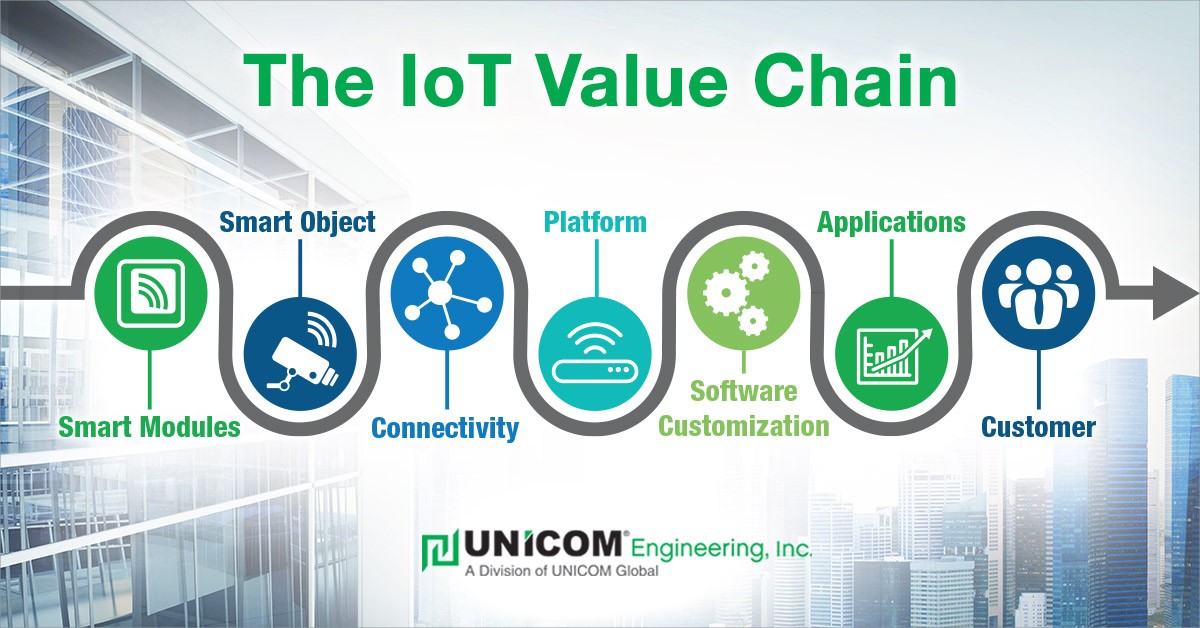In the technology sector, one of the most exciting yet complicated new developments is the tremendous growth of the Internet of Things, and knowing how its value chain works is imperative. The market projections are staggering and driving technology companies to figure out how to get a piece of the action. As with any new technology shift, there are relationships and connections created through the value chain. Understanding where your organization fits and building partnerships early will be critical to success.
A recent article entitled “Internet of Things – Business Models” provided by Telecom Circle analyzes the value chain and partnerships and here is our take on the subject.
Knowing the Value Chain
One of the most complex parts of determining your path to revenue within IoT is the involved value chain. It is complex due to the wide range of interconnectivity required for these devices to function properly. For example, device providers could partner with a system integrator to provide hardware/platforms and build the solution and then they will need connectivity and potentially additional applications in order to produce a single IoT solution. This could quickly become complicated and entangled.
Identifying the key players in each category of the value chain can help you recognize with whom you need to work to augment your products and resources and be successful. The categories include:
- Smart Modules
- Smart Objects
- Connectivity Platforms
- Software Customization
- Applications Customers
Defining the Players in the Value Chain
When you’re trying to carve out your place in the IoT value chain, one of the most important things that you can do is to target a partner who is likely to bring you the highest level of value.
The business groupings poised to take the lead, as well as their best partnering options, include:
- Application Providers - Regrettably, application providers are some of the smallest players in the IoT game. They may be best positioned to be acquired by larger partners and are not likely to work well on their own.
- Device Providers - Device providers must look for ways to develop service-based models in order to increase their position in the IoT. If they are not capable of transitioning to this model, device providers may fall to the role of IoT vendors instead.
- Network Providers - They provide a critical role as connectivity is a vital part of the solution. Will they take the lead? It depends on how much flexibility exists in their business model. Some would suggest that they could end up just being the pipe to the cloud.
- Platform Providers - Platforms are where the real magic of IoT occurs because they are capable of bringing together hardware, services, applications, and connectivity. Platform providers can mean many different things and depend on how they are defined and how their partner will determine their fate.
- Systems Integration - These are big players in the IoT game and their true success will depend on a variety of factors including whether they have good working partnerships with leading platform providers in the industry. Deep technical expertise and services beyond just building the device are critical. From the initial design through support if they can handle the gamut of needs of their customers they will find success. And, partnering with a qualified system integrator may be the relationship you need to take an IoT idea to reality.
UNICOM Engineering is Here to Help
The Internet of Things offers a great opportunity for our business as well as our partners and customers. The key may just lie in who you want to be and how you want to play. As mentioned in the intro, we highly recommend reading about the interesting future of business models and partnerships within the Internet of Things as described in this article provided by Telecom Circle. In addition to full information about the web of partnerships needed to make IoT run, the article features several graphics to make the theory clearer.
Looking for a true value-added integration partner that can help you to figure out how to build and deploy your IoT solution? If so, check out our white paper Plugging into the Internet of Things and learn how your ISVs can anticipate and overcome key IoT challenges.
